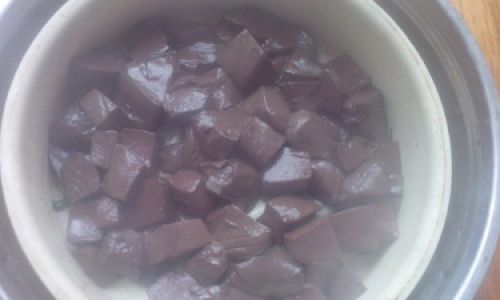Introduction
Pig blood, often referred to as porcine blood, is a common ingredient in various culinary traditions around the world. From blood sausage in Europe to traditional dishes in Asia, pig blood is valued for its unique texture and nutritional benefits. However, consuming stale or contaminated pig blood can pose health risks. Therefore, it is crucial to know how to determine if pig blood is fresh before using it in cooking or any other application. This article will provide comprehensive guidelines on identifying fresh pig blood, covering aspects such as appearance, smell, texture, and storage conditions. By following these steps, you can ensure that the pig blood you use is safe and of high quality.
Understanding Pig Blood: A Nutritional and Culinary Perspective
Before diving into the specifics of identifying fresh pig blood, it is essential to understand its nutritional value and culinary uses. Pig blood is rich in iron, protein, and various vitamins and minerals. These nutrients contribute to its appeal in various culinary contexts. For instance, in some regions, pig blood is processed into blood sausage, which is not only delicious but also a good source of iron. In other cultures, pig blood is used in stir-fries, soups, and stews, adding a unique flavor and texture to the dishes.

Despite its nutritional benefits and culinary versatility, pig blood can quickly spoil if not handled properly. Bacteria and other microorganisms can contaminate the blood, leading to food poisoning if consumed. Therefore, it is vital to ensure that the pig blood you use is fresh and safe for consumption.
Visual Inspection: The First Line of Defense
One of the most straightforward methods of determining if pig blood is fresh is through visual inspection. Fresh pig blood should have a vibrant, dark red color. If the blood appears pale or has a brownish tint, it may indicate that it has been stored for too long or has been exposed to oxygen for an extended period.
Moreover, you should check for any signs of contamination. Fresh pig blood should be clear of debris, such as hair, dirt, or other impurities. If you notice any foreign particles in the blood, it is best to discard it and obtain a fresh batch.
Additionally, pay attention to the consistency of the blood. Fresh pig blood should have a thick, syrupy texture. If it is too watery or has separated into layers, it may be a sign that the blood is no longer fresh.
Olfactory Assessment: The Power of Smell
Another crucial aspect of determining if pig blood is fresh is its smell. Fresh pig blood should have a mild, earthy aroma. If the blood smells strongly of ammonia or has a putrid odor, it is a clear indication that it has spoiled.
Ammonia-like smells often indicate that the blood has undergone bacterial decomposition. This decomposition process produces ammonia as a byproduct, which gives off a pungent odor. Similarly, a putrid smell suggests that the blood has been contaminated with harmful bacteria or fungi, making it unsafe for consumption.
It is important to note that the smell of pig blood can vary slightly depending on the diet and health of the pig. However, a strong, unpleasant odor is always a red flag that the blood may not be fresh.
Tactile Examination: The Feel of Freshness
The texture of pig blood can also provide valuable insights into its freshness. As mentioned earlier, fresh pig blood should have a thick, syrupy consistency. When you touch it, it should feel smooth and slightly sticky.
If the blood feels slimy or has a gritty texture, it may indicate that it has been contaminated with bacteria or other microorganisms. These organisms can alter the texture of the blood, making it less appealing and potentially harmful to consume.
Furthermore, you can perform a simple test by dropping a small amount of pig blood onto a white surface, such as a plate or piece of paper. Fresh blood should form a cohesive drop that retains its shape. If the blood spreads out or forms irregular shapes, it may be a sign that it has lost its viscosity and is no longer fresh.
Checking the Storage Conditions
The storage conditions of pig blood can also provide clues about its freshness. Pig blood should be stored in a cool, dark place to prevent spoilage. Ideally, it should be kept at a temperature below 4°C (39.2°F) to slow down bacterial growth.
If the pig blood is stored at room temperature or in direct sunlight, it will spoil more quickly. High temperatures accelerate the growth of bacteria and other microorganisms, leading to faster decomposition of the blood.

When purchasing pig blood from a supplier, ask about their storage practices. A reputable supplier will store the blood under appropriate conditions to ensure its freshness and safety. If the supplier cannot provide satisfactory answers or if the storage conditions seem inadequate, it is best to avoid purchasing the blood from them.
Considering the Source: The Importance of a Reliable Supplier
The source of the pig blood is another critical factor in determining its freshness. Pig blood obtained from healthy, well-cared-for pigs is more likely to be fresh and safe for consumption. Therefore, it is essential to choose a reputable supplier who can provide information about the health and diet of the pigs.
A good supplier will have strict protocols for handling and storing pig blood to minimize the risk of contamination. They will also be able to provide documentation, such as health certificates, to prove the origin and quality of the blood.
If you are unsure about the supplier’s reliability, ask for recommendations from other chefs, food enthusiasts, or culinary professionals. They may be able to provide insights into the quality and freshness of the pig blood supplied by different vendors.
The Role of Packaging in Preserving Freshness
The packaging of pig blood can also play a significant role in preserving its freshness. Proper packaging can protect the blood from contamination and extend its shelf life.
Ideally, pig blood should be packaged in airtight containers to prevent oxygen exposure, which can lead to spoilage. The containers should also be made of materials that are resistant to bacteria and other microorganisms.
When purchasing pig blood, check the packaging for any signs of damage or leakage. If the packaging is compromised, it may allow bacteria and other contaminants to enter the blood, reducing its freshness and safety.
Conclusion
Determining if pig blood is fresh involves a combination of visual inspection, olfactory assessment, tactile examination, checking storage conditions, considering the source, and evaluating the packaging. By following these steps, you can ensure that the pig blood you use is safe, high-quality, and suitable for your culinary needs.
Remember, fresh pig blood should have a vibrant, dark red color, a mild, earthy aroma, and a thick, syrupy texture. It should be stored in cool, dark conditions and obtained from a reputable supplier with strict handling and storage protocols. Additionally, the packaging should be airtight and resistant to contamination.
In conclusion, knowing how to identify fresh pig blood is crucial for ensuring the safety and quality of your culinary creations. By paying attention to these details, you can enjoy the unique flavor and texture of pig blood while minimizing the risk of food poisoning and other health issues. So, the next time you’re in the kitchen and need to use pig blood, remember to follow these guidelines to ensure that it is fresh and ready for your culinary masterpiece.
This article provides a comprehensive guide on how to determine if pig blood is fresh, covering various aspects such as appearance, smell, texture, storage conditions, the importance of a reliable supplier, and the role of packaging. By following these steps, you can ensure that the pig blood you use is safe, high-quality, and suitable for your culinary needs.





0 comments